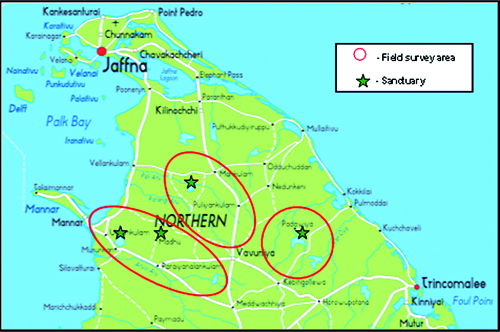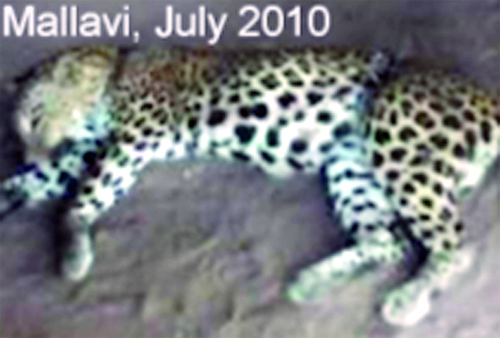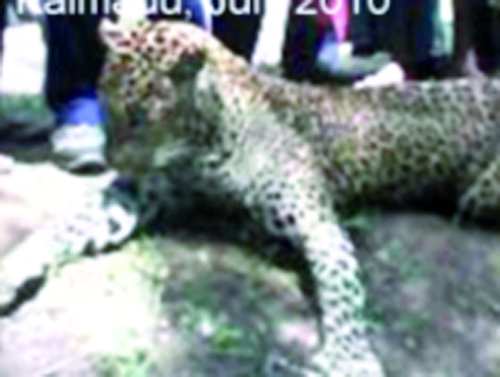Tracking the leopard in the North
Leopard conservation in Sri Lanka has been somewhat neglected until recently, with primary conservation efforts directed towards protecting the Sri Lankan elephant. Realising the need to address this void, the WWCT commenced a full scale research project -The Leopard Project – in 2001 with the approval of the Department of Wildlife Conservation (DWC). The impetus of the project is to further the understanding of the ecology and distribution of this island leopard so as to facilitate more appropriate conservation action within its natural habitat extent.

Map of the Northeast region of Sri Lanka showing surveyed areas
So far WWCT has conducted targeted research in the south east dry zone (Yala NP) and the central hills (Hantane, Agrapatna and Horton Plains NP), with more general island wide distribution surveys ongoing since 2003. This article reports on the recent surveys conducted by WWCT together with DWC staff in post-war areas in the northern dry zone.
Amidst the human cost of the Sri Lankan civil war (1983-2009) it is easy to overlook the conflict’s environmental impact and few would pause to reflect on how the war has affected the island’s wilderness and wildlife.
However documenting the presence of wildlife in former war zones is important to the resettlement process, as the potential for human-wildlife interaction is large in forested areas. Indeed an impetus for the research was the death of five leopards (four caught in snares) in the region in 2010 (Figure 1).
As access was limited during the past 30 years due to the civil conflict, these areas had been neglected by researchers and Wildlife Departmental staff and little is known of the status of wildlife over the past decades.

young adult female killed at Mallavi. (Photos taken by DWC/WWCT staff on a mobile field phone
Field surveys were conducted in the Anuradhapura, Mannar, Vavuniya and Mullaitivu Districts in 2011-2012. The goal of the surveys was to establish a baseline for species’ presence and the degree to which various wildlife species and their habitats are still found in these wilderness areas. The only way to evaluate success of conservation efforts is to establish some baseline values to which significant comparison can be made in the future.
A wide range of species were documented during interview surveys of residents, returning residents and Civil Defence and Armed forces stationed in the area, as well as during opportunistic field visits by WWCT/DWC staff.
Interview surveys also addressed human-wildlife interactions to gauge the level of human-leopard /wildlife co-existence.
Most of the respondents were farmers, which is not surprising given

Pictures show leopards that were trapped in snares in 2010 in Northern Sri Lanka. An adult male killed at Kalmadu
the region’s intensely rural nature. Civil Defence and Armed Forces accounted for over 10 % of the interviewees, signifying that these regions bore the brunt of the conflict.
Generally the status of wildlife in the regions was positive with the majority of respondents citing the presence of endangered species such as the Leopard (85%), the Rusty Spotted Cat (75%) and the Sloth bear (84%). The apparent widespread distribution of the sloth bear is an encouraging sign as they are one of the first species to disappear when their habitat is disturbed.
A significant loss of big trees, especially in Mannar and Vavuniya areas which were high conflict zones was noted when assessing forest habitat change.
Currently large areas of land in the North and East are being developed. It is important that more in depth ground surveys to gain insight into the biodiversity of these regions be conducted.
Balancing the needs of the Sri Lankan people with those of the island’s wildlife is a fundamental need for a small, biodiversity rich, densely populated island such as Sri Lanka.
The ground surveys are important in this regard as they will also help monitor human wildlife interaction within the context of the post war resettlement and development process in these still heavily forested districts of the island.
For more information please contact info@wwct.org; www.wwct.org


